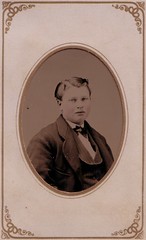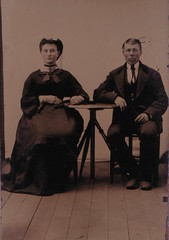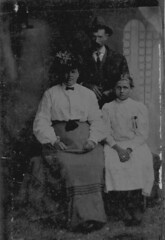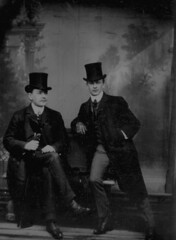Ferrotype

|
| Tintype street photographer. The cylinder behind the photographer's wrist is the developing tank. image by Ben Shahn (Image rights) |
Ferrotypes (also known {in the USA} as Tintypes) are photographs made onto black-enamelled iron plates by the wet-collodion process. The black background made the transparent areas of the negative image appear black, and the dark, silvered areas were whitened using mercuric bichloride, and so appear light - in the same way as glass Ambrotypes.
French photographer Adolphe A Martin was the first to use this process, in 1853. A dry ferrotype processes later replaced the wet-plate system. As the process could be carried out inside the camera and needed no drying time, dry ferrotypes were popular with "while-you-wait" beach and street photographers[1]. Some cameras were advertised specifically for this purpose, such as the Mandel-ette.
Since the image must be viewed from the silvered side of (non-transparent!) plate, the image is left-right reversed (mirror-imaged) - a fault shared with most Daguerreotypes.
The process was used in the US until the early 1940s.

|

|

|

|

|
| Young American | American couple | American family | Two gentlemen | Two young ladies |
- ↑ Focal Encyclopedia of Photography, Focal Press, 1976 edition, p.588
Links
Ferrotype cameras in a past Breker auction catalogue:
- Aptus, for 1¾×2½ inch exposures, by Moore & Co. of Liverpool, c.1910.
- One Minute Camera, by the One Minute Camera Co. of Chigago, 1910-20.
- Mandel-ette, by the Chicago Ferrotype Co., c.1914.
- Unidentified street camera for ferrotype and postcards, c.1910.